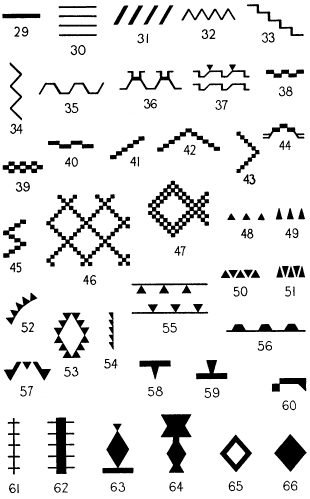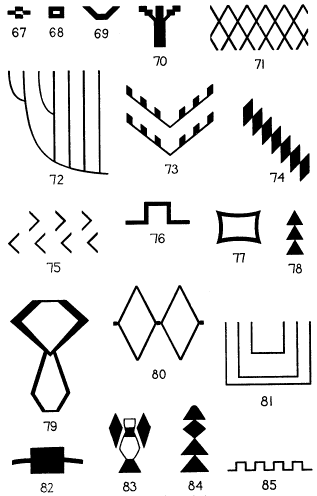
[click to enlarge]
Figs. 29-66.—Basketry designs.
| Online Library: | Title | Author | California | Geology | History | Indians | Muir | Mountaineering | Nature | Management |
Yosemite > Library > Miwok Material Culture > Designs >
Next: Mats • Contents • Previous: Techniques
The designs decorating baskets are simple and the names show an equal simplicity of ideas. In most cases these names indicate geometric forms or are closely related to geometric ideas. A few modifying terms are used in connection with them. The general name for design or pattern is sü'ka (C, S). Very few twined baskets had designs, while virtually every coiled basket did have.
The simple horizontal line or band, or several parallel lines, is frequent. It is called sate'tü or sate'tü tcü (C), lying down straight; or pisi'ssi (S), long stripes (text-figures 29 and 30). One Central Miwok informant gave this type of design the name lūtū'tta.
A series of parallel, vertical, or nearly vertical, lines (figure 31) is called tcīpu'tcü (C), standing erect, and patīwu'ni (S).
The zigzag, horizontally, diagonally, or vertically placed, is called lō'yaa, lōya'asi, or lō'yaûni (C, S), zigzag or crooked. It may be a single line or a number of lines side by side (figures 32-34, variants in figures 35-37). To'toto loyaasī (C) is the tern for the diagonally placed zigzag. Central informants named the horizontal zigzag kītcē'ya (arrowhead) yolō'lī.
Small rectangles connected by their corners to form figures are referred to by the general term lōwō'ta (C), overlapping, held together, and geese or flying geese, because a row of figures suggests a line of flying geese (figures 38-44). Some combinations of rectangles had special names in addition to lōwō'ta (C). Figure 39 was called otī'kō (C), double; figure 40 ma'ilutcü (C) lying down on one’s elbow. Another informant called it wekelē'ya, stretched out sidewise or lengthwise. For figure 43 hutū'ta (S), a row of figures or objects in single file, was given by one informant. Figure 45 was called weke'lunī (S), lengthwise, sidewise, or stretched out, and hutūta lī'let (S), single file vertical.

[click to enlarge] Figs. 29-66.—Basketry designs. |
The general term for the designs in figures 48-57 is kītcē'ya (C), arrowhead. The straight line in figure 55 was called ma'ilutcü (C), lying down on one’s elbow. Figure 56 was called hū'mūtcū (C), moustaches.
In figure 58 is shown a design which occurs as a single figure or as several such figures superposed. It was called ki'liagû (C), horn forehead, and refers to the head of the deer. It was also called mutcilimma kitcē'ya (S), sharp arrowhead. Figure 59 was called yuta'ppa (C), hanging down or fastened. Figure 60 was called tē'wutcü (C), standing on its legs.
Figure 61 was called pisa’lla (C), striped, and tcamu'a (S), dead. The closely related design in figure 62, however, was called hatcī'tcü (C), standing up or resting upon its own base. Figure 63 also was called hatcī'tcü (C), and tcamū'a (S). Further, this latter term was applied to figure 64.
Diamond-shaped designs, such as the open and the solid ones in figures 65 and 66, respectively, are occasional on Miwok basketry. One Central informant called these o'no, signifying gold, apparently derived from Spanish oro, and the figures were evidently conceived as nuggets.
The design in figure 67 was called kahō'na tōbe'pa (S). The first part of the term is derived from the Spanish cajon, box.
In figures 68-76 are a number of rare designs. Figure 77 was called hosakuna (C), star. It was on the bottom of an unfinished coiled basket which began with three-rod coiling and changed to single-rod. Designs 78-84 are additional designs from coiled baskets.
Field Museum basket 70023, from Bald Rock, Tuolumne county, has a design in redbud (Cercis occidentalis) in four horizontal courses, said to represent the measuring worm (figure 85).

[click to enlarge] Figs. 67-85.—Basketry designs. |
Next: Mats • Contents • Previous: Techniques
| Online Library: | Title | Author | California | Geology | History | Indians | Muir | Mountaineering | Nature | Management |
http://www.yosemite.ca.us/library/miwok_material_culture/designs.html